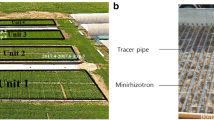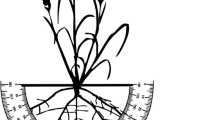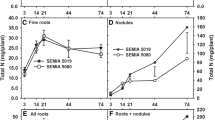Summary
The32P isotope injection technique developed by earlier investigators in graminea has been extensively tested, under irrigated agriculture, using three promising varieties of wheat Pusa Lerma (a single gene dwarf) Sharbati Sonora (a double gene dwarf) and a triple gene dwarf 1634. Field experiments supported by pot experiments using both sand and soil cultures gave identical results.
Unlike the wheats with a succulant stem the legumes are fibrous and do not permit injection in the stem. The technique was, therefore, modified and the injection had to be given on the leaf stem instead of the plant stem.
While equilibrium in wheat was obtained five days after injection both in pot and field experiments mung behaves in a different manner. In the pot experiments the equilibrium could not be attained till the 12th day while in the field experiments it was attained even on the first day after injection. Mung has a thick tap root surrounded by fine secondary roots. The activity was observed to move very fast in the thick tap root even on the first day while the thin secondary roots showed resistance and attained equilibrium on the 3rd day.
The anomaly observed in the pot and field experiments was attributed partly to the differential root growth under the two environments studied and to some extent on the probable loss of fine roots in the collection on the field. However, the plants grown both in pots as well as on the field attained equilibrium on the 12th day. In the case of cowpeas the equilibrium was attained on the 8th day.
The period required for attaining uniform distribution of activity thus seems to be a function of the morphology of the plant, the pattern of the root system and the injection technique adopted. As this is a pre-requisite for the quantitative estimation of the roots care has to be taken in perfecting the technique.
Similar content being viewed by others
References
Fisher, R. A., Statistical Methods for Research Workers.' Oliver and Boyd, Ltd. Edinburgh (1950).
Jackson, M. L., Soil Chemical Analysis'. Constable and Co., London (1958).
Knievel, D. P., Procedure for estimating ratio of live to dead matter in root core samples Crop. Sci.13, 124–126 (1973).
Machanzie, A. J. and Dean, L. A., Procedure for measurement of P31 and P32 in plant material. Anal. Chem.20, 559 (1948).
Racz, G. J., Rennie, D. A. and Hutcheon, W. L., The P32 injection method for studying the root system of wheat. Can. J. Soil. Sci. 44, 100–108 (1964).
Rennie, D. A. and Halstead, E. H., A P32 injection method for quantitative estimation of the distribution and extent of cereal grain roots. Proc. Series: Isotopes and Radiation in Soil — Plant nutrition studies. FAO/IAEA, Ankara, 489–504 (1965).
Russell, R. S. and Ellis, F. B., Estimation of the distribution of plant roots in soil. Nature 217, 582–583 (1968).
Subbaih, B. V., Katyal, J. C., Narasinham, R. L. and Dakshinamurti, C., Preliminary Investigations on Root distribution of high yielding wheat varieties. Intern. J. Applied Rad. Isotope19, 385–390 (1968).
Vijayalakshmi, K. and Dakshinamurti, C., Quantitive estimation of root weight using P32 injection technique. Ind. Soc. Nuclear Agr. Newsletter (in press) (1976).
Author information
Authors and Affiliations
Additional information
Part of the thesis for which Ph.D. degree was awarded to K. Vijayalakshmi by the Indian Agricultural Research Institute, New Delhi.
Dry Land Agriculture Centre, Hyderabad.
Nuclear Research Laboratory, at present International Atomic Energy Agency Expert, Mymensingh, Bangladesh.
Rights and permissions
About this article
Cite this article
Vijayalakshmi, K., Dakshinamurti, C. Limitations of the32P isotope injection technique for the study of the root systems of wheat, mung and cowpeas. Plant Soil 46, 113–125 (1977). https://doi.org/10.1007/BF00693118
Received:
Issue Date:
DOI: https://doi.org/10.1007/BF00693118




